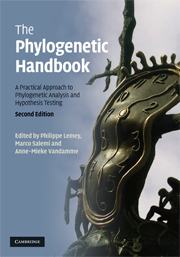Book contents
- Frontmatter
- Contents
- List of contributors
- Foreword
- Preface
- Section I Introduction
- Section II Data preparation
- Section III Phylogenetic inference
- 4 Genetic distances and nucleotide substitution models
- 5 Phylogenetic inference based on distance methods
- 6 Phylogenetic inference using maximum likelihood methods
- 7 Bayesian phylogenetic analysis using MRBAYES
- 8 Phylogeny inference based on parsimony and other methods using PAUP
- 9 Phylogenetic analysis using protein sequences
- Section IV Testing models and trees
- Section V Molecular adaptation
- Section VI Recombination
- Section VII Population genetics
- Section VIII Additional topics
- Glossary
- References
- Index
7 - Bayesian phylogenetic analysis using MRBAYES
from Section III - Phylogenetic inference
Published online by Cambridge University Press: 05 June 2012
- Frontmatter
- Contents
- List of contributors
- Foreword
- Preface
- Section I Introduction
- Section II Data preparation
- Section III Phylogenetic inference
- 4 Genetic distances and nucleotide substitution models
- 5 Phylogenetic inference based on distance methods
- 6 Phylogenetic inference using maximum likelihood methods
- 7 Bayesian phylogenetic analysis using MRBAYES
- 8 Phylogeny inference based on parsimony and other methods using PAUP
- 9 Phylogenetic analysis using protein sequences
- Section IV Testing models and trees
- Section V Molecular adaptation
- Section VI Recombination
- Section VII Population genetics
- Section VIII Additional topics
- Glossary
- References
- Index
Summary
THEORY
Introduction
What is the probability that Sweden will win next year's world championships in ice hockey? If you're a hockey fan, you probably already have a good idea, but even if you couldn't care less about the game, a quick perusal of the world championship medalists for the last 15 years (Table 7.1) would allow you to make an educated guess. Clearly, Sweden is one of only a small number of teams that compete successfully for the medals. Let's assume that all seven medalists the last 15 years have the same chance of winning, and that the probability of an outsider winning is negligible. Then the odds of Sweden winning would be 1:7 or 0.14. We can also calculate the frequency of Swedish victories in the past. Two gold medals in 15 years would give us the number 2:15 or 0.13, very close to the previous estimate. The exact probability is difficult to determine but most people would probably agree that it is likely to be in the vicinity of these estimates.
You can use this information to make sensible decisions. If somebody offered you to bet on Sweden winning the world championships at the odds 1:10, for instance, you might not be interested because the return on the bet would be close to your estimate of the probability. However, if you were offered the odds 1:100, you might be tempted to go for it, wouldn't you?
- Type
- Chapter
- Information
- The Phylogenetic HandbookA Practical Approach to Phylogenetic Analysis and Hypothesis Testing, pp. 210 - 266Publisher: Cambridge University PressPrint publication year: 2009
- 57
- Cited by

